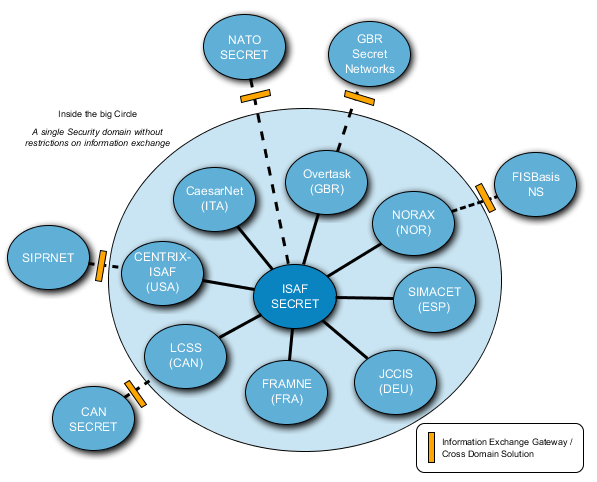Appendix D. The Afghanistan Mission Network (AMN) Profile of NATO Interoperability Standards
- D.1. Purpose
- D.2. Change Management
- D.3. Communication and Network Services Standards
- D.4. Infrastructure and Core Enterprise Services Standards
- D.5. Community of Interest Services and Data Standards
- D.6. Community of Interest Data and System Interoperability
- D.7. Geospatial Interoperability
- D.8. Battlespace Management Interoperability
- D.9. Joint Intelligence, Surveillance, and Reconaissance Interoperability
- D.10. Biometrics Data and System Interoperability
- D.11. User Interface Capabilities/Applications
- D.12. References
D.1. Purpose
322. NATO, through its interoperability directive, has recognized that widespread interoperability is a key component in achieving effective and efficient operations. In many of the operations world-wide in which NATO nations are engaged, they participate together with a wide variety of other organizations on the ground. Such organizations include coalition partners from non-NATO nations, Non-Governmental Organization (NGOs - e.g. Aid Agencies) and industrial partners. The NATO Interoperability Standards and Profile (NISP) provides the necessary guidance and technical components to support project implementations and transition to NATO Network Enabled Capability (NNEC).
323. The figure below characterizes the information environment and various scenarios that exist for exchanging operational information. This environment, although rich in participation and basic connectivity, lacks fully meshed interoperability at the services layer. This diagram represents the AMN environment, and the starting point for future mission network for NATO-led operations. It is presumed for the purposes of this document that the AMN Profile will only address capabilities between the AMN Core and national AMN extensions.
324. The purpose of this document is to define an Interoperability Standards Profile to support the Afghanistan Mission Network (AMN) and transition from today's legacy systems to NNEC by defining a useful level of interoperability.
325. This document will also serve as a resource for NATO C4ISR planners, to be used as a guide in achieving interoperability between NATO nations, coalition partners and NATO provided capabilities. The AMN Profile is for use throughout the complete lifecycle of the ISAF mission. The AMN Profile will enable Net Centric operations by enhancing collaboration across the entire operational environment across all levels of command. Subsequent NATO led missions will benefit from the modular nature of the AMN Profile, which will allow for maximum reuse of established capabilities, while accommodating unique requirements and technology improvements.
326. Additional benefits to deployment and sustained operations include:
-
Speed of execution of operations,
-
Richer information environment,
-
More dynamic information exchange between all members of the network,
-
Speedier standup of an NATO-led operation,
-
Reach-back to feature rich information enterprise(s), and
-
Elimination of hierarchical information flow.
327. Participating nations are encouraged to use this document as part of the planning process for coordination and establishment of connectivity and interoperability with respect to joint NATO-led operations.
328. This profile will be used in the implementation of NATO Common Funded Systems. Nations participating in AMN agree to use this profile at Network Interconnection Points (NIPs) and at other Service Interoperability Points as applicable.
329. NNEC Services must be able to function in a network environment containing firewalls and various routing and filtering schemes; therefore, developers must use standard and well-known ports wherever possible, and document non-standard ports as part of their service interface. Service developers must assume network behavior and performance consistent with the existing limits of these networks, taking bandwidth limitations and potentially unreliable networks into account.
